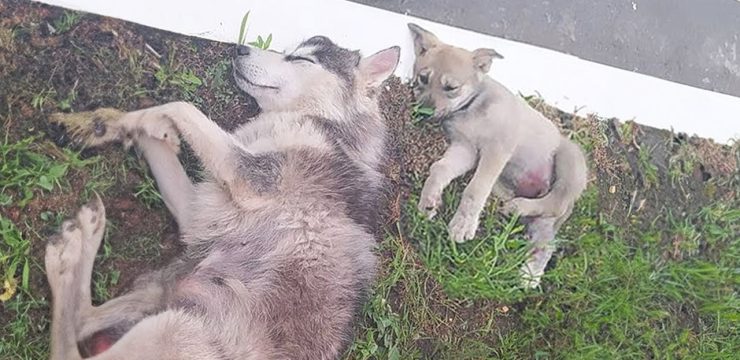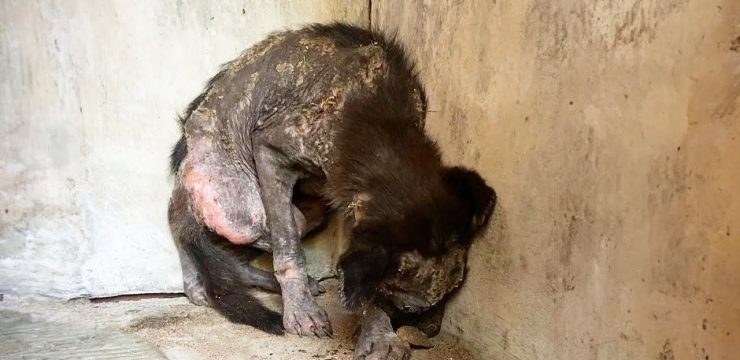Locals in Cumbria, England were taken by surprise when a spiky, dinosaur-like creature was discovered soaking in a small body of water near their homes. The unusual animal, dubbed “Fluffy” by rescuers, is anything but fluffy or cuddly. In fact, this hard-shelled reptile, native to North America, has a powerful bite that can easily sever a finger in one snap.

So what was this prehistoric predator doing in a quiet English tarn? And why is its presence so concerning for the delicate ecosystem of the area?
The story began when a dog walker and their pet were strolling along the edge of Urswick Tarns, a serene body of water surrounded by limestone and known for its rich biodiversity. That’s when they spotted a strange, armor-plated creature sunning itself near the water’s edge. Unsure of what they were looking at, the person quickly took a photo and posted it to Facebook, hoping the online community might help identify the mystery animal.
The photo soon caught the attention of Denise Chamberlain, a member of the Urswick Parish Council who had previously worked in Florida. With her background, she immediately recognized the spiny reptile. “I looked at it and immediately thought, ‘Oh goodness, I know what you are,’” she told PA Media, as quoted by the Guardian. Chamberlain identified the animal as a juvenile alligator snapping turtle – a carnivorous species with a notoriously nasty bite. “These turtles have a natural defense mechanism: when you go near them, they open their mouth,” she explained.
Concerned about the potential threat to local wildlife, Chamberlain sprang into action. The turtle, likely an abandoned pet, was not native to England and posed a serious risk to the fragile balance of life in the tarn. Alligator snapping turtles, which are typically found in swamps and rivers throughout the southern United States, Central America, and South America, can grow up to 200 pounds and live more than 100 years. With no natural predators in the tarn, the turtle could have easily wiped out fish populations and disrupted the entire food chain. “These species are invasive, they’re non-native, and I knew it was going to upset the ecology of the tarn,” she said. “That type of creature, while it’s not going to breed, could do some real damage to the fish stocks and eat all sorts of local wildlife.”
Chamberlain had never handled a creature like this before, so she proceeded with extreme caution. She donned protective gloves and brought a shopping basket to safely contain the turtle. She described how the turtle lurked in the shadows of the water, its beak just above the surface. “It was lurking around the top so it could catch the rays of the sun, but it stays underwater and breathes. It looked like a prehistoric little dinosaur.”
Fortunately, the cold temperature made the turtle sluggish, allowing Chamberlain to scoop it up more easily. “Because it was quite cold and the turtle itself was quite cold, it wasn’t too difficult to maneuver into the shopping basket,” she noted. However, the turtle wasn’t captured without protest. As a warning, it opened its formidable jaws, displaying the strength of its natural defense.
After feeding the turtle some raw chicken to settle it down, Chamberlain transported it to Wild Side Vets in Barrow-in-Furness. The veterinary team had never seen such a creature at their clinic before. “It’s certainly the first one we’ve seen at the clinic – they are kept in the UK but they’re certainly not a common thing you would see at the vets,” said Dr. Kate Hornby, veterinarian and owner of the clinic. “It would certainly give you a nasty nip and it could probably do significant damage to a finger or finger end, but at this size, it’s not particularly dangerous.”
Dr. Hornby and her team emphasized the importance of responsible pet ownership, particularly when it comes to exotic animals. “We believe he had been abandoned at the tarn. If you are struggling to keep your reptile, please feel free to talk to us in confidence – no judgment – and we will do our very best to help,” read a post from the clinic, which also featured photos of the turtle. “Please don’t abandon or keep any reptile in suboptimal conditions. We can help.”
As for Fluffy, the team has yet to determine whether the turtle is male or female due to its young age and size. “We’re calling it Fluffy for now,” the vet said with a smile. Chamberlain added, “I think the name Fluffy is very appropriate – it’s a reference to the creature in Harry Potter. And as someone on Facebook said, it certainly looks like a creature Hagrid would love.”
The story quickly spread across social media, with users expressing their admiration for both the creature and the people who rescued it. “Fluffy – got to love that name for such an unusual creature, but beautiful to see and so glad he/she was brought to you to be taken care of,” one commenter wrote. Another added, “Ahh bless him – so glad he turned up at the right place to find the right people to help him x.” A third chimed in, “Wow, what an awesome looking thing, I mean, I wouldn’t want to cuddle him but still, he’s amazing.”
Fluffy is now being relocated to a wildlife center in Cornwall, where the turtle will live in a more suitable environment with proper care. This heartwarming tale serves as a reminder of the importance of researching and committing to any pet before bringing one home – especially exotic species that require specialized care.
Let’s hope Fluffy thrives in his new environment. And if there’s one takeaway from this unexpected encounter, it’s that nature has a way of surprising us – sometimes in the form of a prehistoric turtle just trying to find a place to call home.





